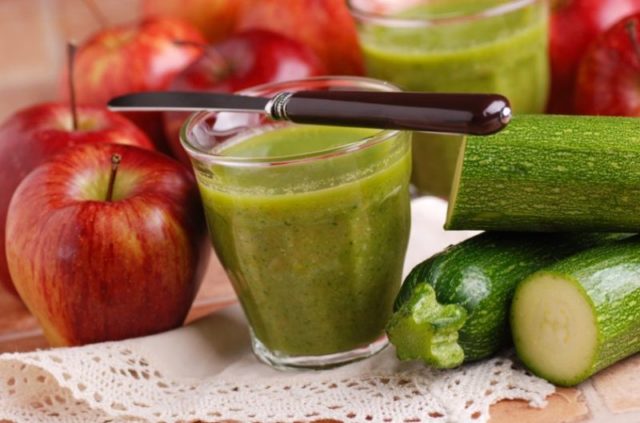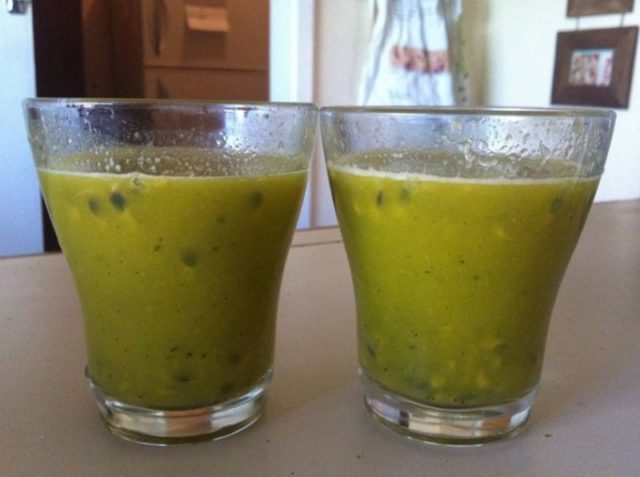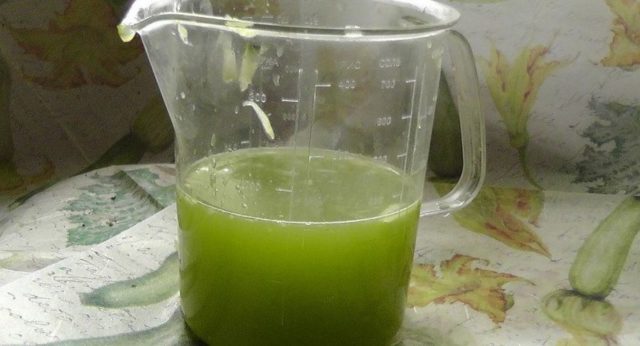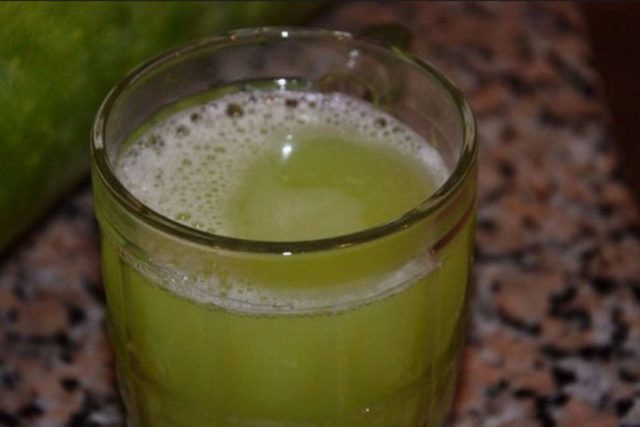Content
Zucchini juice has a non-standard taste, but has a very beneficial effect on the body. You can use it not only for pleasure, but also for medicinal purposes.
Chemical composition
The benefits and harms of zucchini juice are determined by its composition. All the valuable substances that make up the fresh pulp are preserved in the vegetable juice:
- vitamin C;
- cellulose;
- copper and sodium;
- B vitamins;
- phosphorus and magnesium;
- antioxidants;
- folic acid;
- potassium;
- pantothenic acid;
- flavonoids.
The nutritional value of the juice is very low. 100 ml of the product contains only about 24 calories, so the drink does not lead to weight gain.

Why is zucchini juice useful for the human body
When consumed in moderation, fresh squash has a beneficial effect on the body:
- improves diabetes mellitus and levels blood glucose levels;
- normalizes appetite and accelerates metabolic processes;
- promotes weight loss and removes toxins from the body;
- maintains water-salt balance;
- helps fight swelling;
- prevents the development of vitamin deficiency in the autumn;
- has a beneficial effect on the condition of the skin and hair;
- improves peristalsis and prevents constipation;
- has a tonic effect and evens out the emotional background;
- slows down the aging process;
- improves kidney function and protects the liver;
- reduces the level of bad cholesterol;
- strengthens immune resistance;
- lowers blood pressure;
- improves the outflow of bile and removes small stones from the kidneys and bladder.
You can use squash juice to prevent cardiovascular ailments, to increase hemoglobin levels and to relieve inflammation.
Can be taken by pregnant women
Zucchini juice is recommended for use during pregnancy. When used in small doses, it helps to cope with toxicosis and puffiness, prevents the development of constipation and improves the functioning of the nervous system.
The vitamins and minerals in the drink strengthen the body of the expectant mother and contribute to the healthy formation of the fetus. Zucchini fresh does not contain potentially dangerous components, so the main contraindication for it is only an individual allergy.
How to get squash juice
You don't need to buy natural squash juice at the store. You can cook it at home from fruits from your own garden. Young vegetables are best suited for creating a drink - their skin is thin and tender, and the seeds are soft and small in size.
The juice preparation algorithm looks like this:
- Vegetables are thoroughly washed to remove dirt in cool water.
- With a sharp knife, peel the peel from the zucchini and remove the tails.
- Cut the pulp into small slices, cleaning the seeds along the way.
- Put the pieces in a meat grinder or blender and grind to a state of gruel.
- Thoroughly squeeze the resulting puree through cheesecloth folded in several layers.
If you don't have kitchen appliances at hand, you can grate the zucchini on a fine grater. It will take some effort and time, but the results will be just as good.

How to prepare zucchini juice for the winter
For long-term storage, fresh zucchini is harvested along with citrus fruits. Prescription requires:
- zucchini - 1.5 kg;
- orange - 1 pc.;
- sugar - 200 g
Step by step cooking looks like this:
- Zucchini is washed and dried on a towel, and then peeled and chopped in a blender.
- The resulting gruel is squeezed through cheesecloth.
- Pour the squash juice into a saucepan and place on the stove over medium heat.
- Remove the zest from the orange.
- Squeeze the citrus pulp through a sieve and cheesecloth.
- Add fruit juice and zest to the fresh squash.
- Bring the composition to a boil and keep it on low heat for another five minutes.
The finished drink remains poured into sterile jars and tightly rolled up with lids. For two days, the juice is cooled in room conditions, and then transferred to the cellar or refrigerator.

How to take and drink zucchini juice
Squash juice is rarely harmful, but you need to drink it in accordance with some rules:
- Fiber and organic acids in the drink when taken on an empty stomach can cause fermentation in the stomach and intestines. Therefore, it is recommended to use the juice one hour after a meal or shortly before a meal.
- It is best to drink fresh through a straw and in small sips. This will help prevent bouts of nausea and protect your tooth enamel from the damaging effects of organic acids.
- Drinking juice is recommended in the morning or afternoon. If you drink fresh juice at night, it can interfere with restful sleep due to its diuretic effect.
- Sugar is usually not added to the drink - the sweetener reduces the benefits of the product. But to improve the taste, you can add a little honey or carrot, cucumber and celery pomace to the juice.
If you didn't have to use fresh squash before, then you should start with just 50 ml of the product per day during the first week of admission. In the absence of negative reactions, the dosage can be doubled and gradually added by 50 ml, until the daily rate is 500 ml. They drink this volume not at one time, but in small portions three times a day.

The glycemic index of squash juice is only 15 units. You can use it, including with diabetes - the drink will not lead to sharp fluctuations in sugar levels.
Application in cosmetology
The beneficial properties and contraindications of marrow juice are valued not only in medicine, but also in home cosmetology. Vegetable pomace has a positive effect on the condition of the skin, improves the condition of the hair and helps to maintain youth for longer.
Mask for dry skin
Squash juice moisturizes the epidermis well and helps to cope with the first wrinkles. For dry, aging skin, you can use the following product:
- Young zucchini is peeled and peeled.
- Grind the pulp with a blender or manually with a grater.
- Squeeze pure juice through cheesecloth.
- Add egg yolk to the liquid and beat the mixture thoroughly.
- Spread the mask over the washed face and leave for 25 minutes.
Wash off the product with warm water without using soap. With regular use, fresh squash will increase the elasticity of the epidermis and return it youth and freshness.
With age spots
Squash juice has whitening properties and helps to reduce the appearance of freckles and age spots. Apply the tool like this:
- The washed young vegetable is peeled and chopped.
- Squeeze the juice from the pulp and moisten a cloth in the liquid.
- Apply the mask to the face and leave for 15 minutes.
After the expiration date, the skin is rinsed with warm water.
Hair Mask
Zucchini juice nourishes hair follicles, activates their growth and prevents hair loss. A home mask is prepared as follows:
- Squeeze the juice from the pulp of a fresh young squash, previously pitted.
- Mix with 15 ml of olive or sunflower oil.
- Add 100 ml of milk.
- Mix the ingredients thoroughly.
- Distribute the product along the entire length of the curls with a cosmetic brush.
You need to leave the mask for half an hour; it is advisable to cover it on top with a film and a warm towel. After the expiration of time, the product is washed off using a natural shampoo.

With cellulite
The beneficial substances in the fresh squash improve metabolic processes under the skin and reduce the appearance of cellulite. Apply the pomace as follows:
- A small amount of pure juice is obtained from a young juicy vegetable.
- Wet hands in fresh juice.
- Massage problem areas 2-3 times a day for 7-10 minutes with soft but strong movements.
The procedures are continued until visible results appear. If desired, zucchini juice can be mixed with base and essential oils, however, it has a good effect even in pure form.
Mask for oily skin
Squash juice helps cleanse the epidermis and regulate sebum production. With frequent rashes and an unpleasant shine of the face, such a mask is beneficial:
- Fresh juice is squeezed out of a small vegetable and mixed with 10 g of natural honey.
- Add 40 g of grated avocado pulp.
- Add 5 ml of fresh lemon juice.
- Mix the ingredients.
- Spread over the face, avoiding the eye area.
The mask is left for 20 minutes, after which it is removed with warm water. Fresh squash unclogs pores and prevents new breakouts.
Application for weight loss
Low-calorie zucchini contains a huge amount of vitamins and minerals, is well absorbed by the body and does not irritate the mucous membranes of the digestive tract when consumed on a full stomach. On a diet, vegetable juice can be drunk in volumes up to 1 liter per day, combining it with healthy pulp dishes.
Fresh squash helps to drown out the feeling of hunger and removes toxins and toxins from the tissues, contributing to the quick release of extra pounds. It is recommended to take it for a week in a row.
Contraindications to the use of squash juice
The benefits and harms of freshly squeezed zucchini juice are related to each other. Compared to other fruit and vegetable drinks, fresh juice rarely causes negative reactions. But it is still necessary to abandon its use:
- with peptic ulcer;
- with exacerbation of pancreatitis;
- with acute renal failure;
- with hyperacid gastritis;
- with individual allergies.
The safe dosage of squash juice is 200-500 ml per day. In some cases, for example, on a diet or during treatment, it is permissible to consume up to 1 liter of drink per day, but not longer than 1-2 weeks in a row.

If you experience discomfort in the stomach and intestines, you must refuse to use the juice. If abused, it can lead to diarrhea and cramps, as well as dehydration due to its diuretic effect.
Storage conditions and periods
The benefits and harms of juice from fresh zucchini remain maximum in the first half hour after preparation. It is allowed to put it in the refrigerator for a day, but at the same time it should be borne in mind that by the end of the period, it will hardly have any special value.
Fresh zucchini, preserved for the winter with sterilization, retains the benefits for up to one and a half years. In this case, keep the container with the drink in the refrigerator or in the cellar, at a temperature not higher than 10 ° C and away from sunlight.
Conclusion
Zucchini juice has numerous beneficial properties and is appreciated in medicine and in the cosmetic field. You can prepare a drink at home - the process does not take much time.

